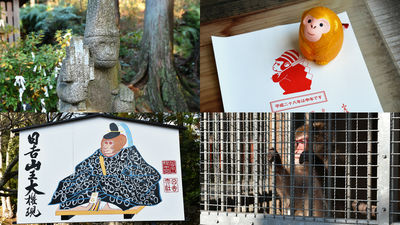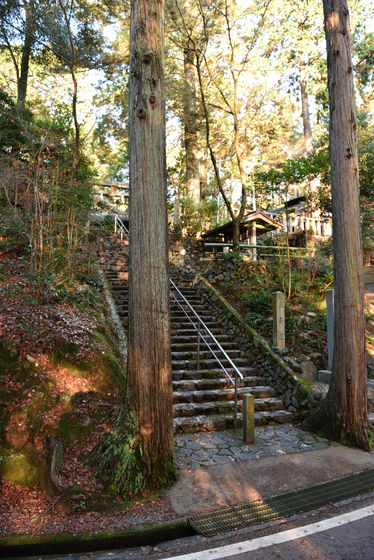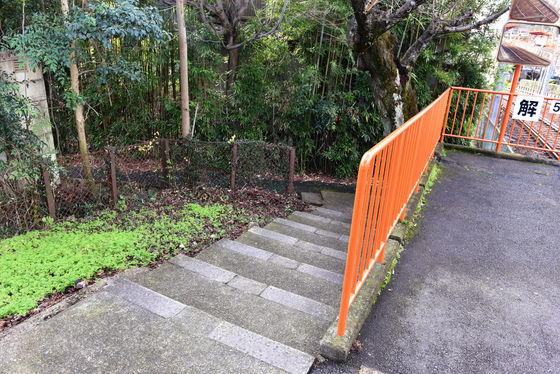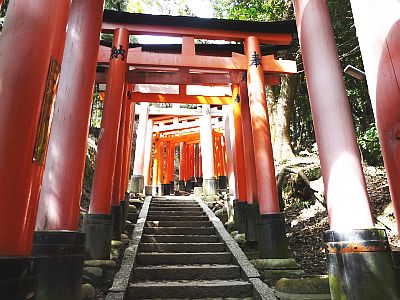I visited temples and shrines suitable for the first visit of the year of the monkey, including Hiyoshi Taisha, where the divine messenger Masaru (Masaru) lives.

The zodiac sign for 2016 is the monkey . There are many shrines that are related to monkeys, but Hiyoshi Taisha Shrine in Shiga Prefecture is home to the divine messenger 'Masaru' who is associated with 'winning' (lucky and sure victory), and is also said to ward off evil spirits as it is located in the direction of the demon gate (northeast) of the Kyoto Imperial Palace. This time, we visited shrines and temples, with a focus on Hiyoshi Taisha Shrine, that are likely to be good candidates for the first shrine visit of the year of the monkey.
◆
First, we will go to Sarumaru Shrine, which is located in Ujitawara-cho, outside of Kyoto City. There are two routes to get there by public transportation: by bus from Uji Station on the Keihan Uji Line or Uji Station on the JR Nara Line, and by bus from Shin-Tanabe Station on the Kintetsu Kyoto Line. This time, we took the route from Uji Station on the Keihan Line.

I got on the bus bound for 'Industrial Park' at the bus stop in front of the station. The nearest bus stop is 'Ichū-mae,' so I could also get on the bus bound for 'Ichū-mae' or 'Ryokuen-zaka.'

After about 33 minutes, you will arrive at the 'Ichu-mae' bus stop. The white building on the left side of the photo is the waiting room. The road on the right is National Route 307, the road in front is in the direction of Uji and Shintanabe, and the road in the back is in the direction of the industrial park and Ryokuenzaka.

There was a sign for the '

I arrived in Uji on the first train of the morning, so the temperature was 1 degree.

From here, we will go around that mountain.

By the way, the official website and many other websites indicate that the 'Ichu-mae' bus stop is the closest, but if you are going to 'Kogyo Danchi' or 'Ryokuenzaka', the neighboring 'Iwayama' bus stop is closer, even though it is only about a two-minute walk away.

Turn left at the traffic light just past the 'Iwayama' bus stop.

Cross the river and turn right at the intersection at the end of the road.

Ahead, turn left again.

From there, just follow the road. The morning sun is rising from the east. It's about a 15-minute walk from here.

There are some areas with sidewalks and some without, and there is a lot of truck traffic, so be careful of what is behind you. It's about a 25-minute walk to this village. Some websites say it's a 25-minute walk from Ichu-mae to Sarumaru Shrine, but the official website and the guide to Ujitawara Town say it's 'about a 40-minute walk.'

Eventually, you will leave the village and Zenjoji Temple will come into view straight ahead.

And halfway up the hill, we finally found Sarumaru Shrine.

There was a bus stop in front of the shrine.

However, the timetable is not divided into 'weekdays' or 'Saturdays and Sundays,' but is written as 'the 13th of every month.' Even during monthly festivals, the bus only operates in the mornings, and three afternoon buses operate only during the Sarumaru Shrine Grand Festival on January 13th, April 13th, and September 13th.

'Sarumaru Shrine, the God of Hump Removal'

Sarumaru Dayu is one of the Six Immortal Poets, known for the waka poem 'Autumn is sad when I hear the cries of the deer groaning as they tread through the autumn leaves deep in the mountains,' which is included in the Hyakunin Isshu.

Sarumaru Shrine enshrines Sarumaru Dayu as 'Sarumaru Okami.'

There is a newer staircase in front, but this is the back approach to the shrine.

If you walk along the road a little further, you will come to the stairs leading to Omotesando.

Once you climb the stairs you will find the main hall.

There are two stone monkeys enshrined in front of the main hall.


Ema is a cute monkey's face that you draw yourself.

Sarumaru Dayu is depicted on the banknote.

Since I was there, I decided to try my luck with a fortune slip (300 yen).

Cute monkey figurine

There is a fortune slip inside.

The grounds are not very large, so if you just want to stop by, it takes about 15 minutes round trip from the bus stop.

On the way back, I took a bus from Ichu-mae bus stop to Keihan Uji station. This time, I left my house on the first bus, but it was already around 9:30 when I got back to Keihan Uji station.

This time I decided to go by train and bus, but it took quite a long time, so unless you really want to walk, it might be better to use a car.

◆Sekizan Zen Temple
Next, we head to Sekiyama Zen Temple in Sakyo Ward, Kyoto City. Take the Eizan Electric Railway from Demachiyanagi Station, get off at Shugakuin Station, and walk east.

From the 'Shirakawa-dori Kitayama' intersection east of the station, it takes 14 minutes to Shugakuin Imperial Villa, and 16 minutes to Sekiyama Zen Temple. The road is the same up until halfway, so just follow the signs to Shugakuin Imperial Villa. From this intersection, head north on Shirakawa-dori.

At the second intersection, just after crossing the Otowa River, turn right. This is the right road, which passes through residential areas.

When you come across a stone at the corner of the road with 'Left Akayama Road' written on it, turn left. Continue straight and you will reach Shugakuin Imperial Villa.

After turning left, continue walking along the road until you come to a crank-shaped curve where you will see a torii gate on your right hand side.

Go through the torii gate and go straight.

On your left you will see Sekiyama Zenin. As the name 'Zen temple' suggests, Sekiyama Zenin is not a shrine, but one of the sub-temples of

This shrine is also located in the northeast direction of Heian-kyo, in the direction of the demon's gate, and is enshrined as the guardian deity of the 'Imperial Palace's front demon's gate.'

It is also the temple of Fukurokuju, one of the Seven Lucky Gods of the Capital, which is said to be the origin of the 'Seven Lucky Gods Tour.'

Perhaps for this reason, there are statues of the Seven Lucky Gods lined up in front of the Fukurokuju Hall.

There is a large 'Sho-nenju' (praying beads) in front of the main hall. It is said that if you think of the wish that comes to your mind as you pass through here and keep thinking about it throughout your worship, and then as you pass through the final 'Kan-nenju' (returning beads), you can pray to the Buddha for his strength, and he will surely protect you.

The beams of the main hall were carved with elephants.

From this alone, it seems like a shrine that has nothing to do with 'monkeys.' However, pay attention to the roof of the worship hall.

There was a red monkey in the center. This monkey is holding a sacred wand and a kagura bell to ward off evil spirits, and corresponds to the monkey at the northeast corner of the palace, and protects the palace. The wire mesh is not to prevent theft, but to keep the monkey from escaping because it used to cause trouble every night.

On the way back, instead of Shugakuin Station, I got off at Miyake-Hachiman Station, which is also on the Eizan Electric Railway, but I don't recommend it because the roads around the station are narrow and a bit confusing. You can enter from the passage to the east side of the platform, next to the railroad crossing.

Staircase entrance to the west side of the home.

The alley leading to the stairs is so narrow that even looking at the map I worry whether I'm on the right path.

The 'Miyake Hachiman' in the station's name is a shrine located on the north side of the station. The shrine itself is more than a 10-minute walk away, just like Sekiyama Zenin, but you can see the torii gate standing at the foot of Miyake Bridge from the end of the platform.

Eizan Electric Railway is scheduled to introduce an IC card system in March 2016, so it is a bit of a hassle that you cannot use PITAPA or ICOCA yet. Prior to the introduction of the IC card system, the magnetic card SuruTtoKANSAI will no longer be usable from January 31st.

There was already an IC card reader on the platform.

And even at this station, which is not a terminal station like Demachiyanagi, there are posters for the TV anime adaptation of '

Manga Time Kirara and Eizan Electric Railway have collaborated on many occasions, such as wrapping trains, and at Demachiyanagi Station there was a life-size panel of the main character, Aoba Suzukaze, installed as part of

◆
Hiyoshi Taisha Shrine is a famous spot for viewing autumn leaves, and is also known as 'Hiyoshi is synonymous with monkeys.' The nearest station is Sakamoto Station on the Keihan Ishiyama Sakamoto Line, so head to Sakamoto Station from Keihan Hamaotsu Station.

Inside Sakamoto Station there is a panel featuring

This is what Sakamoto Station looks like from the outside.

There is a bus from the station operated by Koyo Transportation that goes through Hiyoshi Taisha Shrine. There are 2-3 buses per hour. It's not that far to walk, but it's a gentle uphill climb.

If you look to your left from the bus stop, you will see a torii gate.

This torii gate is just the starting point.

We walk while looking at the splendid old townscape.

It takes about 5 minutes to reach the red torii gate.

A votive plaque depicting 'Hiyoshi Sanno Daigongen' and a large monkey.

To help protect the cultural heritage, an admission fee of 300 yen for adults and 150 yen for children is required.

It's been uphill up to this point, but we cross the stone Omiya Bridge and continue climbing.

Once you reach the top of the hill, you will see the Sanno Torii gate. The triangular gable (roof) on top of the torii gate is a symbol of Sanno faith. A similar torii gate can be found at Hie Shrine in Akasaka, Tokyo, which is also home to the Sanno faith, and Hiyoshi Taisha is the head shrine of the 2,000 Hiyoshi, Hie, and Sanno shrines across the country. Originally, Hiyoshi Taisha was pronounced 'Hietaisha,' but after the war, its official name became 'Hiyoshitaisha.'

At Hiyoshi Taisha Shrine, there is a messenger from the gods called

'Masaru' is related to 'evil warding off' which protects against evil spirits, and 'win' which means victory.

The sacred horse is a wooden statue, but the monkey is a real one. However, it is forbidden to feed the monkey, so if you have any food, please give it to the shrine office.

Nishi-Hongu Shrine is located at the very back of the shrine grounds.

At each of the four corners under the eaves of the tower gate, there are sacred monkeys called 'Munemochizaru,' each in a different pose.

There is also a monkey-faced ema here.

The brown divine monkey fortune telling slips for warding off evil and bad luck cost 300 yen, while the golden one for warding off bad luck and increasing financial luck costs 500 yen.

By the way, the East Shrine also has a tower gate similar to that of the West Shrine.

However, there are no Munemochi monkeys under the eaves of the East Shrine.

There are a few soba restaurants around Sakamoto Station, but if you're not too hungry, you can also eat 'Shanao-mochi' at a teahouse. It's rice mashed like gohei-mochi, kneaded into triangles and baked, each one spread with bean paste and sesame miso.

◆ Sarutahiko Shrine
The last one is Sarutahiko Shrine in Ukyo Ward. There are many Sarutahiko Shrines in Japan, and it is said that the head shrine is Sarutahiko Shrine in Ise City, Mie Prefecture, or Tsubaki Grand Shrine (Sarutahiko Daihongu) in Suzuka City, Mie Prefecture, but this Sarutahiko Shrine in Ukyo Ward is known as ' Yamanouchi Koshin ,' one of the three Koshin shrines in Kyoto and Raku.
The nearest stations are Uzumasa Tenjingawa Station on the subway or Randen Tenjingawa Station on the Keifuku Arashiyama Main Line (Randen).

I walk along the road, watching the Arashiyama Dentetsu train enter its own dedicated track.

Soon you will see a convenience store, and beyond that a lush green area. This is Sarutahiko Shrine.

The bridge on the west side of the shrine is called Sarutahiko Bridge.

The Arashiyama train runs through the south side of the station.

After crossing Sarutahiko Bridge and walking a little, turn around to your right and you will see Sarutahiko Shrine.

The enshrined deity, Sarutahiko Okami, is worshipped as the 'god of opening the way' and the 'god of guidance in life,' and is known for his divine virtues of bringing good fortune, warding off disasters, and warding off illness.

There are also votive plaques like this one that say 'see no evil, hear no evil, speak no evil.'

However, since the shrine office is unmanned during normal times, there was a sign that said to purchase talismans and amulets at Sanno Shrine, located north of the Yamanouchi tram stop, about a five-minute walk in the direction of Shijo-Omiya.

This is the easiest of the four to access.

Related Posts:
in Coverage, Posted by logc_nt







